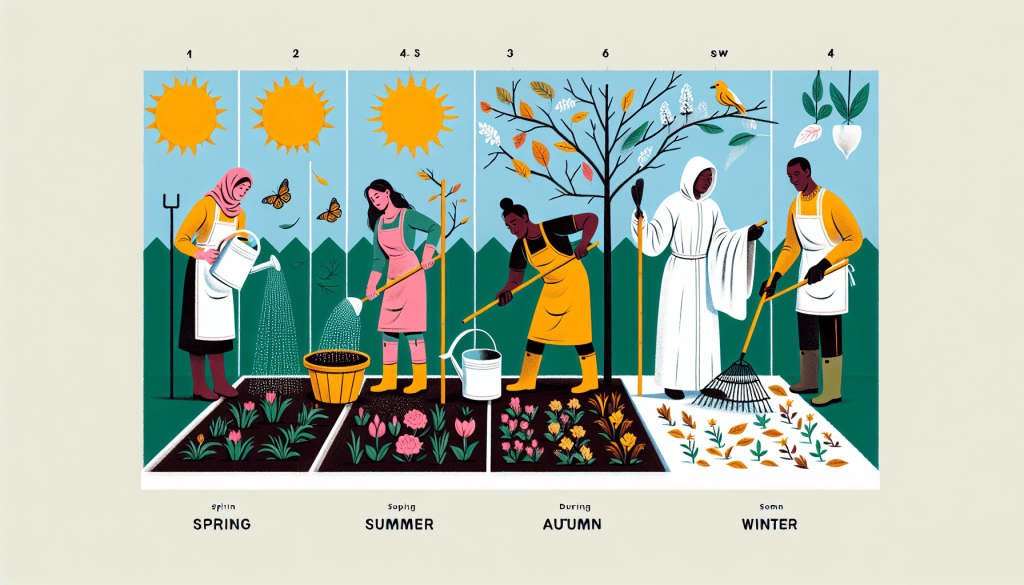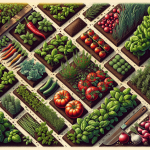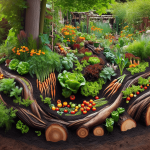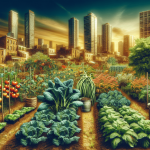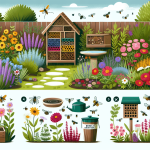This post may contain affiliate links. As an Amazon Associate, we may earn commissions from qualifying purchases.
As a gardener, you understand the ever-changing nature and needs of your plants. With each season, a different set of tasks awaits, ensuring that your garden thrives and flourishes. From sowing seeds in spring to protecting your plants from frost in winter, this article will provide you with a comprehensive guide to the most important gardening tasks to tackle throughout the year. Get ready to nurture your green haven and witness the joy of a beautiful and bountiful garden in every season.

Spring
Prepare the soil
In the spring, it is essential to prepare your soil for planting. Start by clearing any debris or weeds from the area. Then, loosen the soil with a garden fork or tiller to improve drainage and aeration. Adding organic matter, such as compost or aged manure, will enrich the soil with essential nutrients. This will create a fertile foundation for your plants to grow and thrive. Take the time to test the pH level of your soil and adjust it accordingly if necessary.
Plant seeds and seedlings
Spring is the perfect time to start planting seeds and seedlings in your garden. Consider the specific needs of each plant, such as sunlight requirements and spacing. Carefully follow the instructions on the seed packets or plant tags. As you plant, be mindful of the weather conditions and the average last frost date for your area. Choose a variety of plants that will offer a blend of colors, textures, and heights to create a visually appealing garden.
Start composting
Composting is a fantastic way to reduce waste and create nutrient-rich soil for your garden. Begin by setting up a compost bin or pile in a convenient location in your yard. Add a mix of green materials, such as fruit and vegetable scraps, grass clippings, and coffee grounds, along with brown materials like leaves and shredded newspaper. Remember to turn the compost regularly to promote decomposition. By starting composting in the spring, you will have a steady supply of compost to use throughout the year.
Prune fruit trees
Proper pruning is crucial for maintaining the health and productivity of your fruit trees. In the spring, before buds start to open, take the time to prune any dead, damaged, or crossing branches. This will improve air circulation, reduce the risk of diseases, and encourage new growth. Pay attention to the specific pruning requirements of each fruit tree variety, as different trees may have different needs. By pruning in the spring, you will help your fruit trees flourish and produce bountiful harvests.
Check irrigation systems
As the weather warms up, it’s important to ensure that your irrigation systems are in proper working order. Inspect your sprinklers, drip lines, and hoses for any leaks, clogs, or damage. Clear away any debris that may obstruct the flow of water. Make adjustments to the timers and settings to accommodate the changing needs of your plants. Adequate and efficient watering is essential for the health and growth of your garden, so take the time to check and maintain your irrigation systems in the spring.
Clean garden tools
Before diving into your spring gardening tasks, take a moment to clean and organize your garden tools. Remove any dirt, rust, or debris from shovels, rakes, and pruners. Sharpen the blades for clean and precise cuts. Oil any moving parts to prevent rust and ensure smooth operation. By starting the season with clean and well-maintained tools, you’ll be better equipped for a successful gardening experience.
Summer
Weed and mulch
In the summer, weeds can quickly take over your garden and compete with your plants for nutrients and water. Take the time to regularly weed your garden beds, removing any unwanted plants from their roots. Mulching is another effective method to suppress weed growth, retain moisture, and regulate soil temperature. Apply a layer of organic mulch, such as straw, wood chips, or shredded bark, around your plants. This will also enhance the aesthetics of your garden and create a more polished look.
Water regularly
With the warm temperatures of summer, it’s crucial to water your garden consistently to prevent wilting and dehydration. Monitor the moisture levels of your soil and adjust your watering schedule accordingly. Use water at the base of the plants to minimize evaporation and ensure that the roots are adequately nourished. Consider investing in a drip irrigation system or soaker hoses for more efficient watering. Remember to water early in the morning or in the evening to reduce water loss due to evaporation.
Deadhead flowers
To keep your summer flowers blooming and looking their best, regularly deadhead them. Deadheading is the process of removing faded or spent flowers, which promotes continuous blooming and prevents the plant from diverting energy into producing seeds. Use clean and sharp pruners or scissors to make clean cuts just above a set of healthy leaves or buds. By regularly deadheading your flowers, you’ll encourage more vibrant and prolonged blooms throughout the summer.
Harvest fruits and vegetables
Summer is a season of abundance in the garden, as many fruits and vegetables ripen and become ready for harvest. Keep a close eye on your plants and harvest the produce when they reach the peak of their ripeness. This includes tomatoes, cucumbers, berries, beans, and more. Harvesting regularly will not only provide you with fresh and delicious produce for meals but also encourage the plant to continue producing. Don’t forget to share the bountiful harvest with friends, family, and neighbors.
Monitor pests and diseases
Summer is the time when pests and diseases can become more prevalent in your garden. Regularly inspect your plants for any signs of infestations or damage, such as holes in leaves or discolored patches. Identify the pests or diseases and apply appropriate treatments or natural remedies to control them. Encourage beneficial insects and birds into your garden to help with pest control. By monitoring pests and diseases closely, you can intervene early and prevent them from causing significant damage to your plants.
Feed plants
During the summer months, your plants are in a phase of rapid growth and require additional nutrients to support their development. Apply a balanced fertilizer or organic compost to enrich the soil and supply essential nutrients. Follow the instructions on the fertilizer package and apply it according to the specific needs of your plants. This will help them stay healthy, vibrant, and resilient throughout the summer season.
Fall
Clean up garden beds
As summer comes to a close, it’s time to clean up your garden beds and prepare them for the colder months ahead. Remove any spent plants, fallen leaves, or debris from the garden beds. This will reduce the risk of pests and diseases overwintering in the garden. Consider composting the healthy plant material or disposing of it if it shows signs of diseases. By cleaning up your garden beds in the fall, you’ll ensure a fresh start for the following growing season.
Plant bulbs for spring
Fall is the perfect time to plant bulbs that will bring vibrant colors to your garden in the spring. Choose a variety of bulbs, such as tulips, daffodils, and crocuses, and follow the planting instructions provided. Dig holes at the appropriate depth and spacing, and place the bulbs with the pointed end facing up. Cover them with soil and water thoroughly. The cool temperatures of fall will provide a period of dormancy, allowing the bulbs to establish strong roots and bloom beautifully in the spring.
Divide and transplant perennials
Many perennials benefit from dividing and transplanting every few years to maintain their vigor and promote new growth. As the weather cools in the fall, dig up clumps of perennials, such as hostas or daylilies. Gently separate the plants into smaller sections, each with their own set of roots and foliage. Replant the divided sections in well-prepared soil, ensuring they have enough space to grow and thrive. Dividing and transplanting perennials in the fall will revitalize them for the following season.
Collect and save seeds
Fall is the perfect time to collect and save seeds from your favorite plants. Allow the flowers and seed pods to mature and dry on the plant. Once they have turned brown and crispy, carefully collect the seeds and store them in labeled envelopes or containers. Make sure the seeds are completely dry before sealing them. Saving seeds from your garden will allow you to grow the same plants in future seasons, preserving their characteristics and adding a personal touch to your garden.
Prepare garden for winter
Before the cold weather sets in, it’s crucial to prepare your garden for the winter months. Clean and store any garden tools or equipment that won’t be used during this time. Cut back any dead or damaged plant material to tidying up the garden. Apply a layer of mulch or compost around the base of trees, shrubs, and perennials to help insulate the roots and protect them from freezing temperatures. By preparing your garden for winter, you’ll create the best conditions for your plants to survive and thrive.
Remove fallen leaves
Fall is known for its beautiful foliage, but it’s also a time when leaves tend to fall and accumulate on the ground. Regularly rake and remove fallen leaves from your garden beds, as they can smother plants, block sunlight, and encourage pests and diseases. Consider adding the collected leaves to your compost pile or use them as mulch in other areas of your garden. By removing fallen leaves, you’ll keep your garden tidy and promote a healthier environment for your plants.
Winter
Protect plants from frost
During the winter months, it’s essential to protect your plants from frost and extreme cold temperatures. Cover sensitive plants with frost blankets, burlap, or old bedsheets to provide insulation. Consider moving potted plants indoors or placing them in a sheltered location, such as a garage or shed. Mulch around the base of trees and shrubs to provide additional protection for their roots. By taking measures to shield your plants from frost, you’ll increase their chances of surviving the winter and thriving in the spring.
Repair and maintain garden structures
Winter is an excellent time to inspect and repair any garden structures, such as fences, trellises, or raised beds. Replace any damaged or rotting components, ensuring that the structures are sturdy and secure. Apply a fresh coat of paint or wood preservative to protect against the elements. Regular maintenance will prolong the lifespan of your garden structures and keep your garden looking its best.
Plan and design for next season
Winter provides a fantastic opportunity to dream, plan, and design your garden for the upcoming season. Consider the layout, colors, and themes you want to incorporate. Research new plants and varieties that you’d like to add to your garden. Create a detailed planting schedule and make a list of necessary supplies or tools. By planning and designing during the winter, you’ll be well-prepared and excited to see your vision come to life in the spring.
Research new plants and techniques
Use the winter months to expand your gardening knowledge and explore new plants and techniques. Read books, magazines, or online resources to learn about different garden styles, plant combinations, or cultivation methods. Research specific plants that you’d like to add to your garden and understand their requirements. Stay updated with the latest gardening trends and practices. By continuously learning and experimenting, you’ll enhance your gardening skills and discover new possibilities for your garden.
Attend garden workshops or classes
Consider attending garden workshops or classes during the winter to further enhance your gardening skills and gain inspiration. Many gardening centers, botanical gardens, and community organizations offer educational programs and events. These workshops may cover various topics, such as pruning techniques, soil preparation, or container gardening. Sign up for a few classes that align with your interests and areas you’d like to improve. By attending garden workshops or classes, you’ll learn from experts and fellow garden enthusiasts while connecting with your local gardening community.
Enjoy indoor gardening
While your outdoor garden may be dormant during the winter, you can still enjoy the wonders of gardening indoors. Set up a small indoor garden with houseplants or herbs. Experiment with different plant varieties and containers to create a pleasing display. Provide the necessary care, such as proper lighting, watering, and humidity levels. Indoor gardening brings a touch of nature into your home and allows you to continue nurturing your green thumb even during the colder months.
